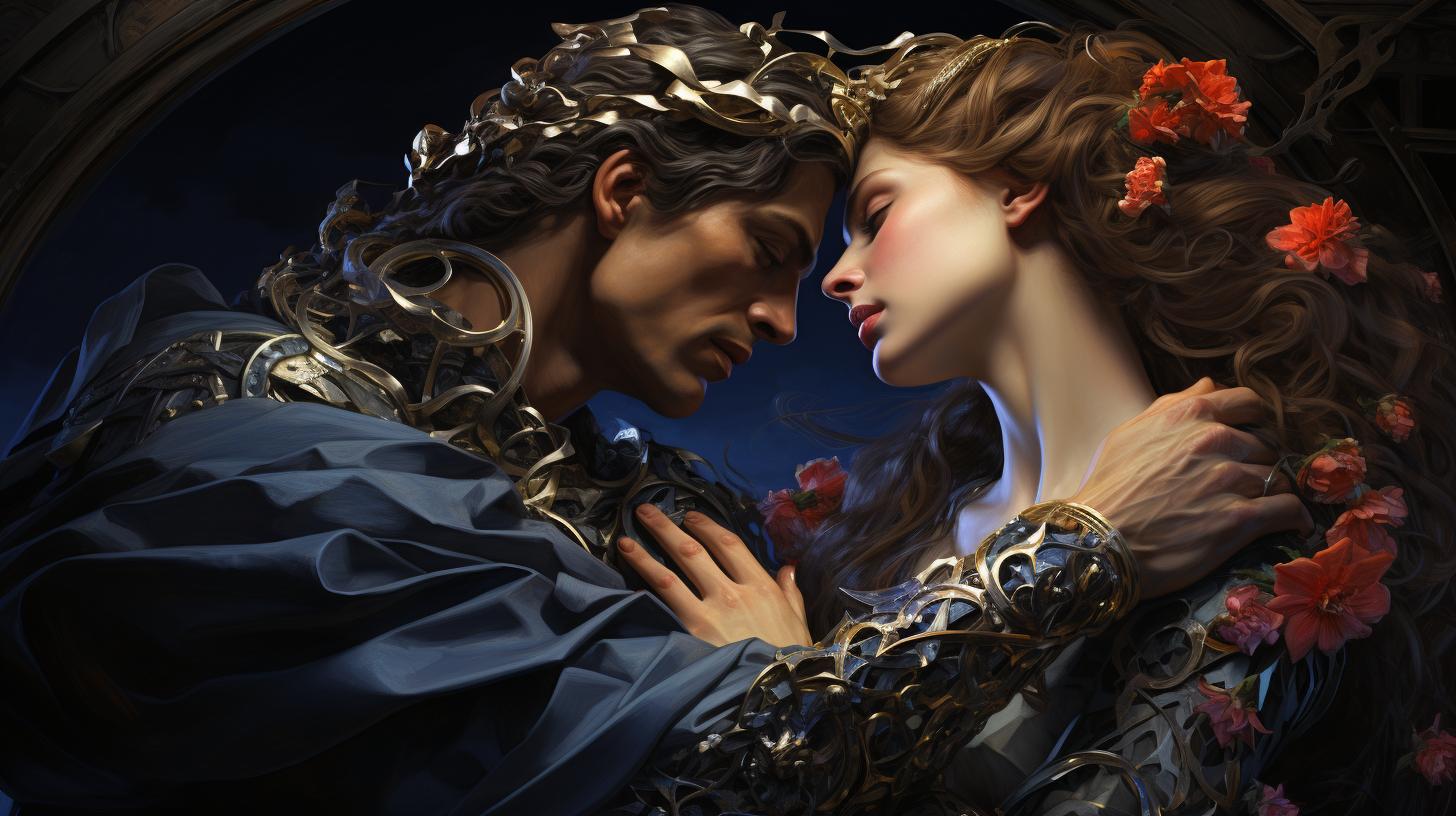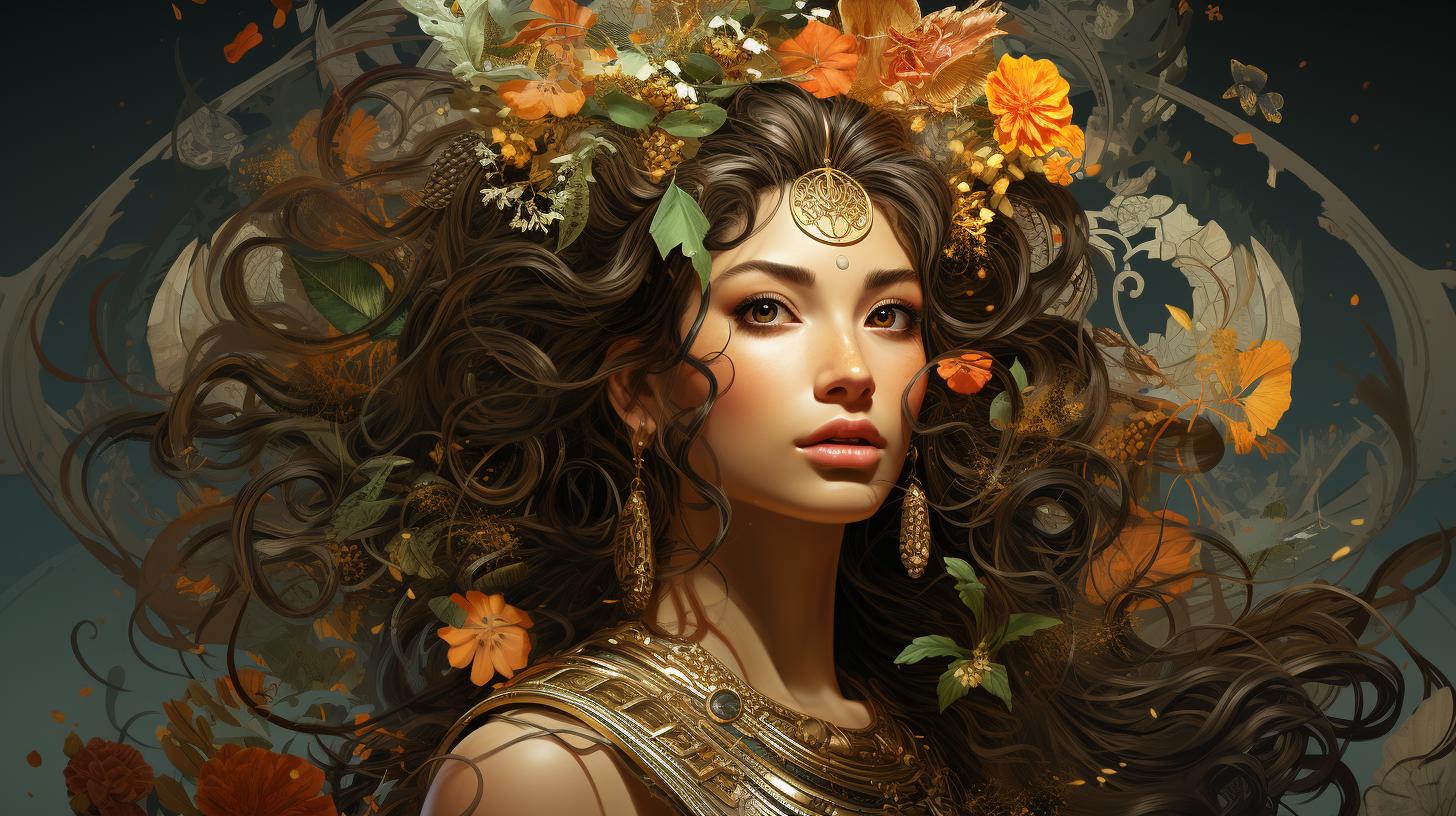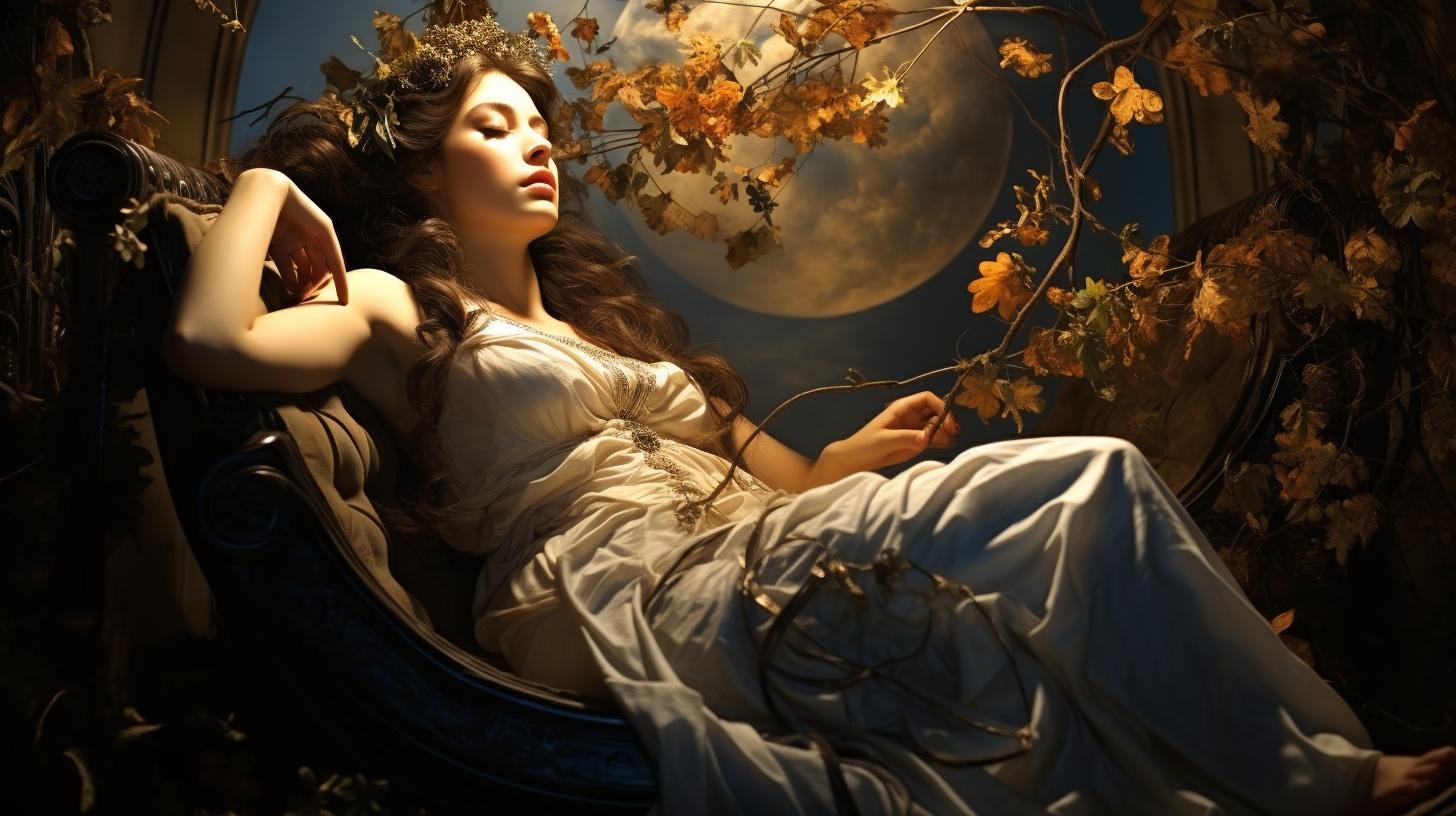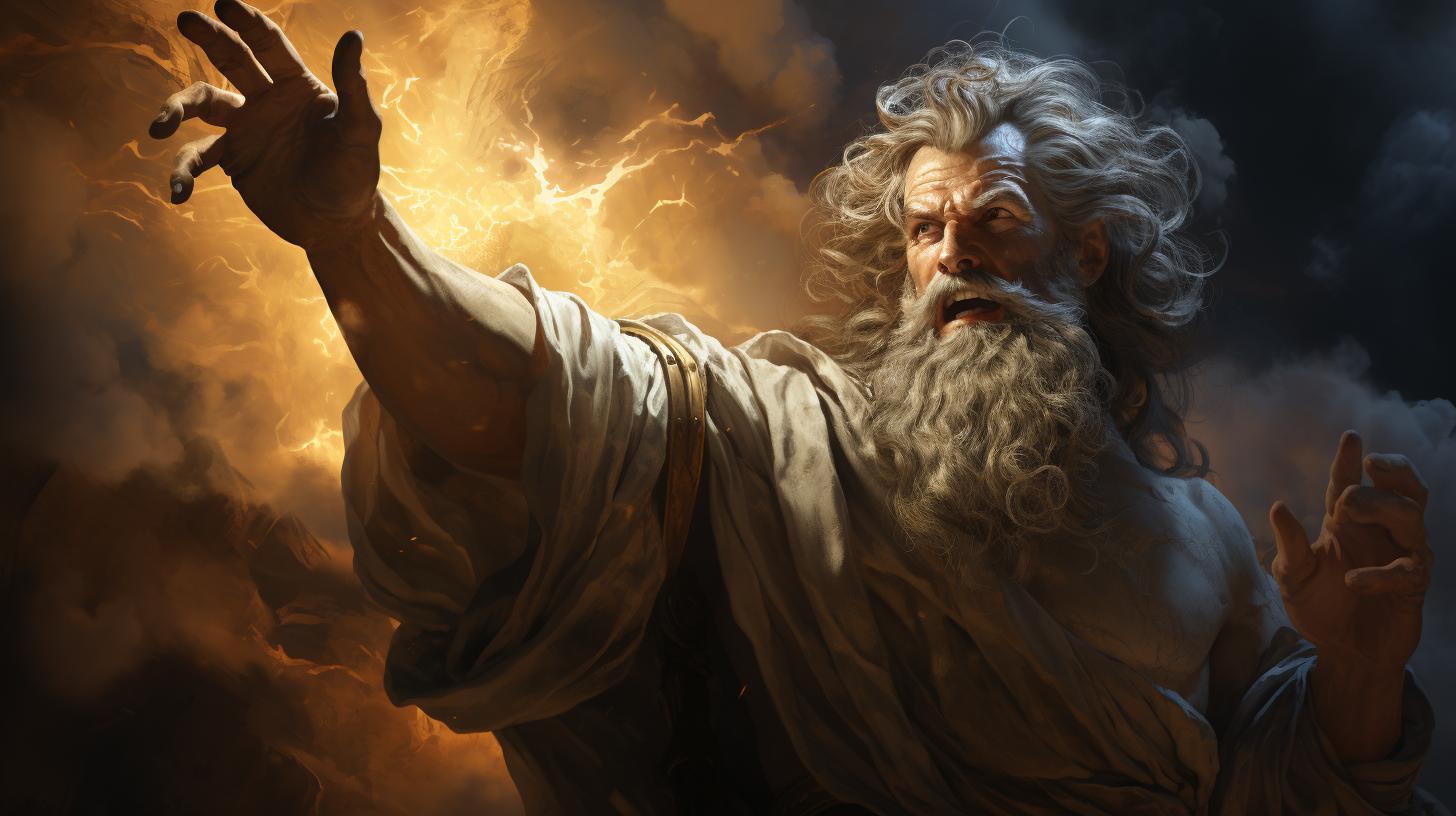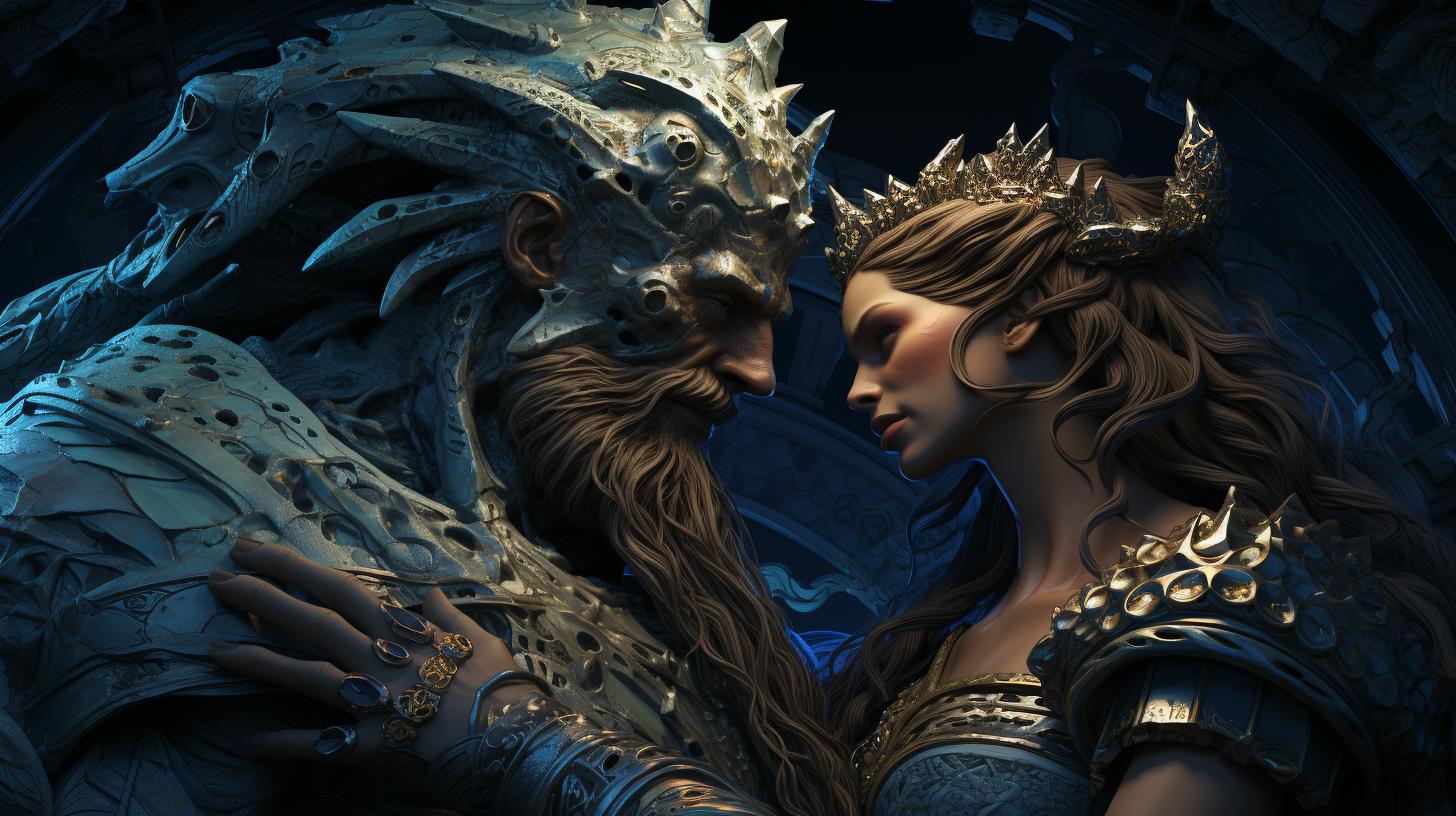Harmonia: The Greek Goddess of Harmony Explained
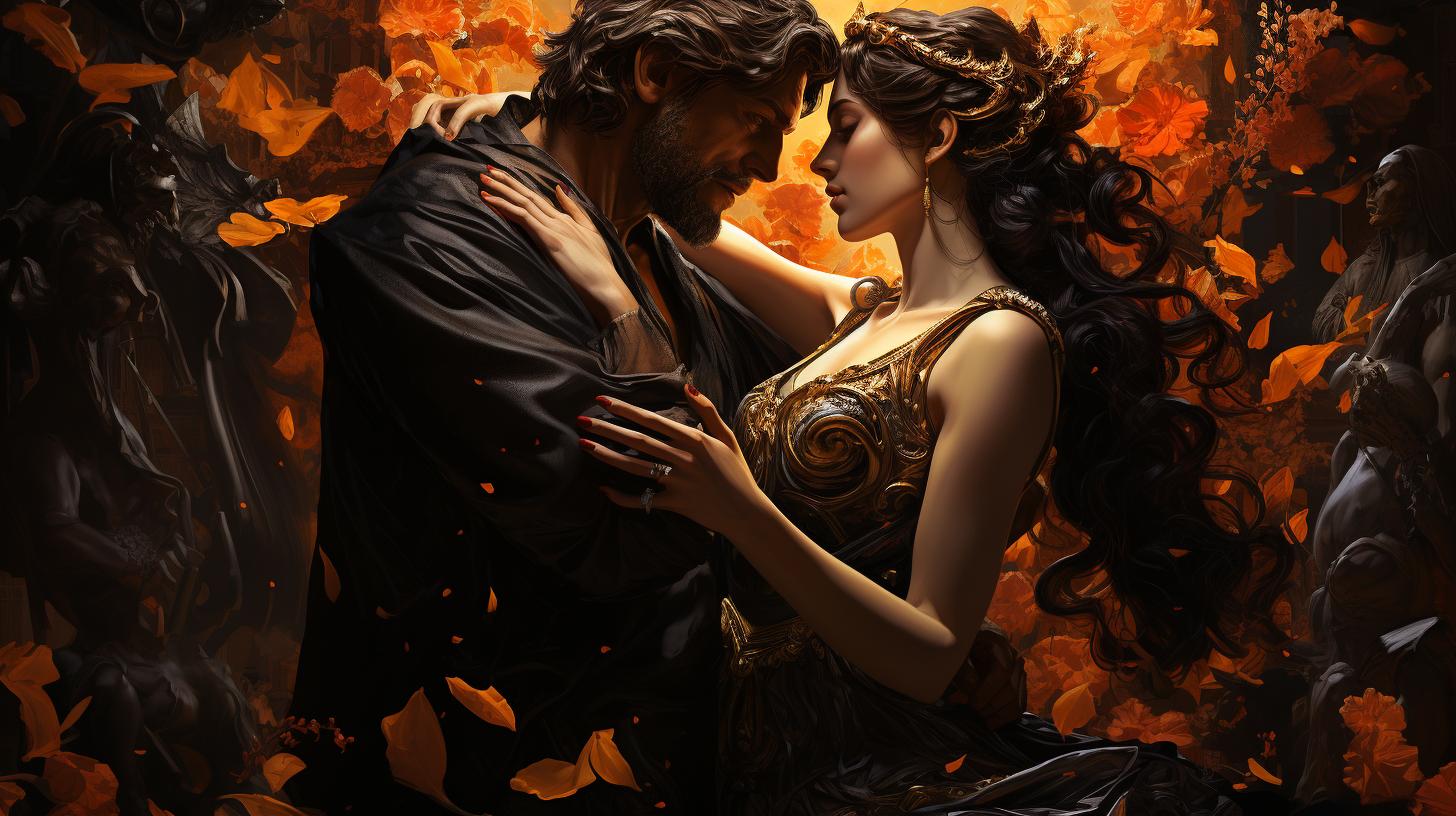
Harmonia, the Greek goddess of harmony, occupies a significant role in Greek mythology. Believed to be the daughter of Ares and Aphrodite, or in some variations, Zeus and Electra, her union with Cadmus brought forth several children.
Notably, she is renowned for the cursed necklace received on her wedding day, which brought misfortune to its possessors. Harmonia and Cadmus also faced tragic family events and eventually transformed into serpents.
This article explores Harmonia’s origins, her cursed necklace, and her ultimate metamorphosis, shedding light on her revered status in Greek religion and mythology.
The Mythology of Harmonia: Exploring the Greek Goddess of Harmony
In Greek mythology, Harmonia stands as a figure of great significance.
This section delves into the intriguing world of Harmonia, the Greek goddess associated with harmony and concord. Through exploring her origins and family connections, Harmonia’s pivotal role in Greek mythology becomes evident.
Additionally, her symbolism and attributes shed light on the depth of her influence and significance within the ancient Greek pantheon.
The Origins and Family of Harmonia
Harmonia’s lineage traces back to prominent gods and goddesses. While some versions attribute her parentage to Ares and Aphrodite, others claim she is the daughter of Zeus and Electra. This varying parentage reflects the richness and complexity of Greek mythology.
Regardless of her specific lineage, Harmonia’s divine heritage sets the stage for her role as a goddess in her own right.
Harmonia and Her Role in Greek Mythology
As the goddess of harmony and concord, Harmonia played a vital part in Greek mythology. Her influence extended beyond familial connections to the broader dynamics of the gods and goddesses.
Harmonia’s presence ensured balance and unity, promoting harmonious interactions among deities and mortals alike. Understanding her role within the Greek pantheon provides valuable insight into the intricate web of relationships and narratives that comprise Greek mythology.
The Symbolism and Attributes of Harmonia
- Symbol of Balance: Harmonia symbolizes the delicate balance between opposing forces, bridging gaps and fostering understanding.
- Representative of Concord: Harmonia embodies the essence of concord, promoting peaceful resolutions and collective well-being.
- Goddess of Unity: Harmonia’s presence inspires unity and cohesion among individuals, communities, and even deities.
- Harbinger of Prosperity: Harmonia’s influence brings forth prosperity and abundance, nurturing harmonious relationships throughout society.
By exploring the symbolism and attributes associated with Harmonia, we gain a deeper appreciation for her role as the goddess of harmony and the profound impact she had on ancient Greek culture and belief systems.
The Marriage and Descendants of Harmonia
Harmonia, the Greek goddess of harmony, had a legendary love story with Cadmus, which captivated the hearts of many across ancient Greece. Their union symbolized the coming together of different divine lineages and sparked a great destiny for their descendants.
Harmonia’s Union with Cadmus: A Legendary Love Story
The tale of Harmonia and Cadmus is one filled with passion, sacrifice, and divine intervention. According to myth, Cadmus, the founder of Thebes, sought the guidance of the god Apollo after slaying a sacred dragon.
As a punishment, he was ordered to serve the god for eight years.
During his time of servitude, Cadmus met Harmonia, the daughter of Ares and Aphrodite, or in some versions, Zeus and Electra. Their connection was instantaneous, and together they embarked on a profound journey, symbolizing the harmonious union between war and love.
Children of Harmonia and Cadmus
The union between Harmonia and Cadmus bore fruit in the form of several notable children, each with their own unique destinies and contributions to Greek mythology. Let us explore the offspring of this divine couple:
Ino, Polidoro, Autonoé, Agave, and Sémele: The Offspring of Harmonia
- Ino, known for her tragic fate, became a crucial figure in the story of Dionysus and his struggles.
- Polidoro, with his lineage intertwined with the royal bloodline of Thebes, played a significant role in the city’s history.
- Autonoé, the mother of Actaeon, experienced the heart-wrenching transformation of her son into a stag.
- Agave, known for her involvement in the myth of Pentheus, bore witness to the destructive power of Dionysus.
- Sémele, who became the mother of Dionysus himself, endured the fiery wrath of her lover’s divine form.
Ilírius: Harmonia’s Youngest Son
Among Harmonia and Cadmus’ children, Ilírius holds a distinct position as the youngest born.
Though fewer tales center around his deeds, it is believed that he played a significant role in the spread of Greek culture and the establishment of new settlements.
This lineage of Harmonia and Cadmus would go on to shape the course of Greek mythology and leave an indelible mark on the ancient world.
The Myth of Harmonia’s Cursed Necklace
Harmonia, the Greek goddess of harmony, is intimately linked to a fabled item known as the cursed necklace. This necklace, given to her as a wedding gift, carried with it a dark and tragic fate that befell all those who possessed it.
The cursed necklace’s story is replete with misery and sorrow, leaving a trail of devastation in its wake.
The Infamous Gift and Tragic Consequences
It is said that the cursed necklace bestowed upon Harmonia on her wedding day brought nothing but misfortune and despair. Its origin and purpose remain shrouded in mystery, but its impact on the lives of those who possessed it was undeniable.
Each subsequent owner suffered the weight of this malevolent artifact, enduring tragedy and calamity that seemed to be inexorable.
The necklace first passed into the hands of Polinices, who bestowed it upon his sister, Eriphyle, in an attempt to manipulate her into persuading their husband, Amphiaraus, to join the war against Thebes.
Little did they know, this act of treachery would set off a chain of events that would seal their fate. The necklace’s presence only exacerbated the conflict, leading to disastrous consequences for all involved.
Polinices, Eriphyle, and the Fateful Necklace
Polinices, driven by his desire for power and control, entrusted the cursed necklace to Eriphyle, knowing her weakness for material wealth. With the necklace as leverage, Polinices sought to sway Eriphyle’s loyalties toward advancing his own ambitions.
However, this ill-conceived plan would ultimately prove to be their downfall.
As predicted, Eriphyle succumbed to the allure of the necklace and agreed to convince Amphiaraus to join the war. In doing so, she sealed her husband’s fate, as he met his demise on the battlefield.
The cursed necklace not only brought ruin upon Eriphyle’s household but also served as a chilling testament to the power it held over the lives of those who possessed it.
- This cursed necklace weaved a web of pain and suffering.
- Its malevolent influence continues to haunt those who encountered it.
- The tragic consequences of possessing the necklace serve as a cautionary tale.
- None who crossed its path could escape the agony it wrought.
The cursed necklace’s dark legacy did not end there.
Passed down through generations, it eventually found its way into the hands of a tyrant named Fáilos, who gifted it to his lover. Yet, as had become customary, the necklace claimed more lives.
The poor woman lost her sanity, engulfing her own house in flames and perishing alongside her possessions.
This harrowing tale of the cursed necklace stands as a reflection of the deep-rooted belief in Greek mythology that certain objects possess an inherent malevolence.
The cursed necklace serves as a timeless reminder of the consequences that befall those who succumb to greed, manipulation, and the desire for power.
Metamorphosis and Aftermath: Harmonia and Cadmus’ Fate
In this section, we delve into the tragic events that befell Harmonia and Cadmus and the subsequent transformations that shaped their fate.
Tragedies and Transformations in Harmonia’s Life
Harmonia and Cadmus, despite their legendary love story, were not spared from the tragedies that plagued their lives. Their existence was marred by grief and misfortune, leading to their ultimate transformation.
Throughout her life, Harmonia endured heart-wrenching losses and witnessed the downfall of her loved ones. The cursed necklace, a harbinger of calamity, brought nothing but sorrow and despair to those who possessed it.
Its influence twisted the paths of those involved, causing pain, betrayal, and even death.
Harmonia’s journey was marked by immense sorrow and grief, as she witnessed her children’s sufferings and agonizing ends.
The weight of their tragic fates weighed heavily on her soul, forever changing her as a person.
The Serpent Metamorphosis and Exile to the Islands of the Blessed
As the tragedies mounted, it became clear that the gods held no mercy for Harmonia and Cadmus. In a final act of divine intervention, their forms were transformed into serpents, symbolizing the eternal consequences of their actions and the enduring burden they carried.
In their serpent forms, Harmonia and Cadmus were banished to the remote and ethereal Islands of the Blessed. Here, they found refuge from the tumultuous mortal world, living out their days in a state of eternal exile.
Their destiny as serpents served as a reminder of the everlasting consequences of their choices, forever separated from the world they once knew. Their metamorphosis marked the culmination of their tragic journey, a testament to the profound impact their lives had on Greek mythology and the concept of harmony.
- Harmonia and Cadmus’ tragic journey
- The cursed necklace’s influence
- The sorrow and grief endured by Harmonia
- The serpent metamorphosis and exile to the Islands of the Blessed
Overall, the fate of Harmonia and Cadmus serves as a cautionary tale that explores the consequences of actions and the immutable nature of destiny.
Their story continues to captivate and remind us of the delicate balance that must be maintained in the pursuit of harmony.
The Role of Harmonia in Greek Religion and Mythology
Harmonia, the Greek goddess of harmony, holds a significant place in Greek religion and mythology. Her presence is felt through various aspects, from her significance in religious practices to her interactions with other gods and goddesses, as well as her influence on mortals through mythological tales.
Harmonia’s Significance in Greek Religious Practices
In Greek religious practices, Harmonia represents the fundamental concept of harmony and concord. She is revered as a deity who brings balance and unity to both the divine and mortal realms.
Worshipers seek her blessings to ensure peace, cooperation, and smooth relations among individuals, families, and communities.
Her temples and sanctuaries serve as gathering places for devotees to offer prayers, sacrifices, and rituals that seek her guidance in maintaining harmony in their lives.
The religious festivals dedicated to Harmonia are celebrated with joy and reverence, embodying the importance of harmony in the Greek religious tradition.
Harmonia in the Pantheon: Interactions with Other Gods and Goddesses
Within the pantheon of Greek gods and goddesses, Harmonia holds a unique position.
As the goddess of harmony and concord, she acts as a unifying force among the divine entities. Harmonia’s divine presence facilitates peaceful interactions, settlements of disputes, and resolutions of conflicts among the gods and goddesses.
She is often called upon during divine gatherings and councils to mediate and reconcile differences, ensuring a harmonious coexistence. Harmonia’s influence on other deities reinforces the divine understanding of the significance of harmony and its role in maintaining order and stability in the cosmos.
Harmonia’s Influence on Mortals: Examples from Mythological Tales
Mythological tales depict Harmonia’s direct impact on mortals. She is often portrayed as a mediator in human disputes, facilitating reconciliations and fostering peaceful resolutions. In these stories, Harmonia’s guidance helps individuals and communities overcome conflicts, fostering unity and cooperation.
Furthermore, Harmonia’s tale of the cursed necklace serves as a cautionary reminder of the consequences of disrupting harmony. The tragic outcomes associated with the necklace emphasize the importance of maintaining harmony and the potential dangers of discord within interpersonal relationships and society as a whole.
- Harmonia’s role in promoting peace and harmony
- Interactions with gods and goddesses
- Influence on mortals through mythological tales
- Cautionary tale of the cursed necklace
Debunking Common Misconceptions and Popular Beliefs about Harmonia
Harmonia, being a Greek goddess of harmony, has garnered various misconceptions and popular beliefs throughout history.
This section aims to debunk some of these misconceptions and shed light on the true nature of Harmonia, as well as explore the contrasting aspects with similar deities like Athena, Artemis, and Aphrodite.
Hesiod’s Theogony and Other Classical Sources
One common misconception about Harmonia arises from Hesiod’s Theogony and other classical sources.
It is often believed that Harmonia was a minor goddess with little significance. However, a closer examination of these sources reveals that Harmonia was actually highly revered and held a prominent role as the personification of harmony and concord.
In Hesiod’s Theogony, Harmonia is mentioned as the daughter of Ares and Aphrodite or Zeus and Electra. While different versions exist, all sources agree on her divine parentage and her status as a significant figure in Greek mythology.
Furthermore, her marriage to Cadmus, the founder of Thebes, further solidifies her importance and connects her to the prominent events in Greek history.
Contrast with Similar Deities: Athena, Artemis, and Aphrodite
Another misconception revolves around comparing Harmonia to similar deities like Athena, Artemis, and Aphrodite. While all these goddesses share aspects of femininity and power, they have distinct roles and attributes.
- Athena: Often mistaken as the goddess of harmony, Athena represents wisdom, strategy, and warfare. While she resided in harmony with herself, her focus was not on societal or emotional harmony like Harmonia.
- Artemis: Known as the goddess of the hunt and the moon, Artemis embodies independence and nature.
Although she possesses internal harmony, her purpose differs greatly from that of Harmonia.
- Aphrodite: Often associated with love, beauty, and desire, Aphrodite’s domain overlaps with Harmonia’s to some extent.
However, Aphrodite’s influence is more focused on passion and romantic love, whereas Harmonia represents broader harmony in relationships and society.
While there may be some similarities between these goddesses, understanding their distinct roles helps debunk the misconception that Harmonia is merely a derivative or less significant deity compared to others.
By dispelling these misconceptions and examining Harmonia’s true significance in Greek mythology, we gain a deeper understanding of her role as the goddess of harmony and concord.
Harmonia in Modern Culture and Artistic Depictions
Harmonia, the Greek goddess of harmony, continues to captivate artists and culture enthusiasts alike with her timeless appeal.
Her significance and influence are evident in both ancient and contemporary art, as well as in various forms of literature and music.
Visual Representations of Harmonia in Ancient and Contemporary Art
In ancient art, Harmonia is often depicted as a graceful and elegant goddess, embodying harmony and concord.
She is represented wearing intricate garments, adorned with symbols of balance and unity. Artists skillfully captured her serene presence through the use of intricate details and harmonious compositions.
In modern art, Harmonia’s visual representations continue to inspire creativity.
Artists draw from ancient depictions but also infuse their personal interpretations, giving Harmonia a contemporary relevance. Paintings, sculptures, and digital art depict her in various styles, reflecting the artist’s individual vision while staying true to her essence.
Harmonia’s Iconic Imagery
Harmonia’s iconic imagery often includes elements symbolizing harmony, such as musical instruments, intertwined serpents, or balanced scales. These symbols serve as a reminder of her divine role and her ability to bring unity and balance to the world.
Portrayals in Mythological Scenes
Artists frequently depict Harmonia in mythological scenes, showcasing her interactions with other gods and goddesses and her involvement in significant events. These visual narratives capture the essence of Harmonia’s character and her impact on the broader Greek mythological landscape.
Harmonia’s Influence on Literature and Music
Harmonia’s influence extends beyond visual art and permeates the realms of literature and music. Writers and composers have drawn inspiration from her fascinating story, often using her as a metaphor for achieving balance and unity.
7.2.1 Symbolism in Literature
- Authors frequently incorporate Harmonia’s symbolism into their works, exploring themes of harmony, peace, and reconciliation.
- Her story serves as a powerful allegory for societal conflicts and the pursuit of inner harmony.
- Through her character, writers delve into the complexities of human relationships and the transformative power of finding balance.
7.2.2 Harmonia’s Melodies: Music Inspired by the Goddess
- Composers throughout history have composed music inspired by Harmonia and her association with harmony.
- Her mythological significance has been musically interpreted through compositions that convey a sense of unity, balance, and tranquility.
- From classical symphonies to contemporary pieces, Harmonia’s influence can be heard in compositions that aim to evoke feelings of harmony and concord.
Whether in ancient depictions or contemporary adaptations, Harmonia’s presence in art, literature, and music continues to evoke a sense of balance and unity, reminding us of the enduring value of harmony in our lives.
Exploring the Legacy of Harmonia: Her Impact on Concepts of Harmony and Concord
Harmonia, the Greek goddess of harmony, continues to exert a profound influence on our understanding and appreciation of harmony and concord. Her enduring symbolism and relevance in society today are evident in various aspects of our lives, ranging from interpersonal relationships to artistic expressions.
Harmonia’s Enduring Symbolism and Relevance in Society Today
The symbolism associated with Harmonia resonates with us in modern times, as we strive for harmony and balance in our personal and professional lives. Harmonia represents the ideal state of unity and cooperation, where discord and conflict are resolved, allowing for peaceful coexistence and collaboration.
Her image as a goddess of harmony serves as a reminder of the importance of fostering understanding, empathy, and compromise, both on an individual and societal level. In a world often characterized by division and discord, Harmonia’s legacy urges us to seek common ground and promote harmony among diverse perspectives and cultures.
Furthermore, Harmonia’s symbolism extends beyond interpersonal relationships and reaches into various realms of society, including politics, economics, and environmental sustainability. Her principles of harmony and concord inspire us to strive for balanced and equitable systems, where all individuals and communities can thrive in harmony with one another and the natural world.
The Influence of Harmonia’s Story on Philosophical and Spiritual Thought
Harmonia’s story has captivated philosophers and spiritual thinkers throughout history, inspiring discussions on the nature of harmony and the pursuit of inner peace. Her narrative serves as a metaphorical journey, highlighting the challenges and rewards of achieving inner balance and harmony.
Philosophers often draw upon Harmonia’s story to explore the interconnectedness of various aspects of life and delve into the philosophical concept of unity and harmony. Her mythological tale prompts contemplation on the harmonious integration of contrasting elements and the pursuit of holistic understanding.
In spiritual contexts, Harmonia’s story serves as a source of inspiration for those seeking spiritual enlightenment and balance. Her transformation into a serpent and subsequent exile symbolize the shedding of superficial layers and the journey towards self-realization and transcendence.
- Harmonia’s story reflects the universal human desire for harmony and the quest for spiritual transformation.
- Her influence resonates in various spiritual practices and teachings, emphasizing the importance of inner harmony and connection with the divine.
- By contemplating Harmonia’s story, individuals can find guidance on their own personal journeys towards harmony and self-discovery.
In conclusion, Harmonia, the Greek goddess of harmony, leaves an indelible mark on our understanding and pursuit of harmony and concord.
Her enduring symbolism and relevance in society today inspire us to embrace unity, seek balance, and foster harmonious relationships, both in our personal lives and in the broader global context. The influence of Harmonia’s story extends beyond mythology to philosophical and spiritual realms, guiding individuals on their quest for inner peace and enlightenment.
.

